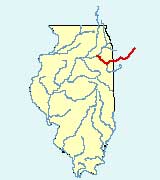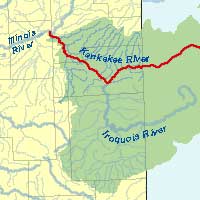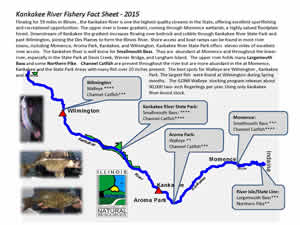Choose another river
Kankakee River


©Illinois State Water Survey
![]() Kankakee-Iroquois River Fishing Guide
Kankakee-Iroquois River Fishing Guide
Description: The Kankakee River runs from its origin near South Bend Indiana to the confluence with the Des Plaines River near Channahon. Flowing for a total of 59 miles in Illinois , the Kankakee River contains 3 dams and twelve larger tributary streams, including the Iroquois River. The upper river is low gradient, running through the Momence wetlands, a high quality floodplain forest. Downstream of the Kankakee, the gradient increases, flowing over bedrock and cobble through the Kankakee River State Park and past Wilmington, joining the Des Plaines to form the Illinois River.
An angler can fish from a canoe or jon boat, try his luck from shore or wade the stream. Caution must be used, since there are sharp dropoffs and deep holes in the river.
The Kankakee is predominantly a clear, shallow stream with gravel-rubble riffles, sand-bottom pools and swampy marsh areas along the upper portion. Larger pools are formed by dams at Momence, Kankakee and Wilmington, as well as by the Dresden Lock and Dam on the headwaters of the Illinois. An aquatic resource of about 3,338 acres exists on the Kankakee.
River Access: Shore access and boat ramps can be found in most of the larger towns along the river, including Momence, Aroma Park, Kankakee, and Wilmington. The Kankakee River State Park offers eleven miles of excellent river access.
Status of the Sport Fishery: The Kankakee River is a very high quality system, supporting a high diversity of fishes and mussels. It is well known as an excellent sport fishery for smallmouth bass, walleye, channel catfish, rock bass, and northern pike.
The best smallmouth action occurs in early spring and fall. Spinners, crank baits, jigs and similar artificials are good on the spunky fish, but minnows, worms, frogs and crayfish also can produce. Riffles, creek mouths and fast water below dams are good for "bronzebacks."
Quieter areas, like backwaters of the Des Plaines Conservation Area along the river, are good spots for largemouth bass. Quiet water also is a good spot for northern pike, which also are taken behind islands and ebb areas formed by tributaries.




